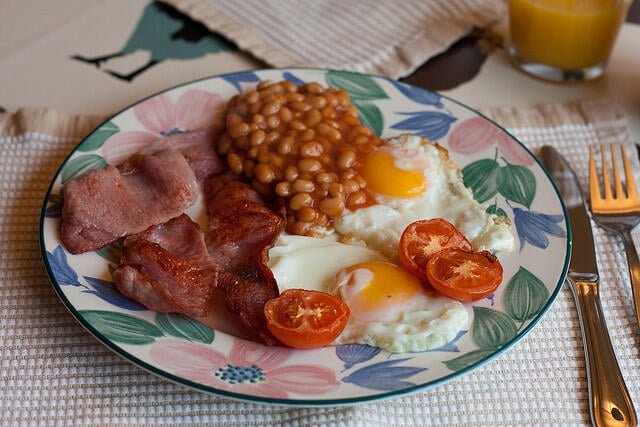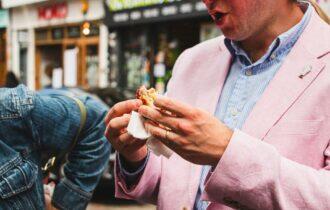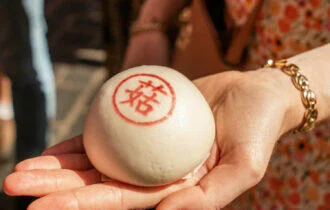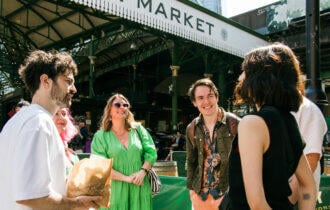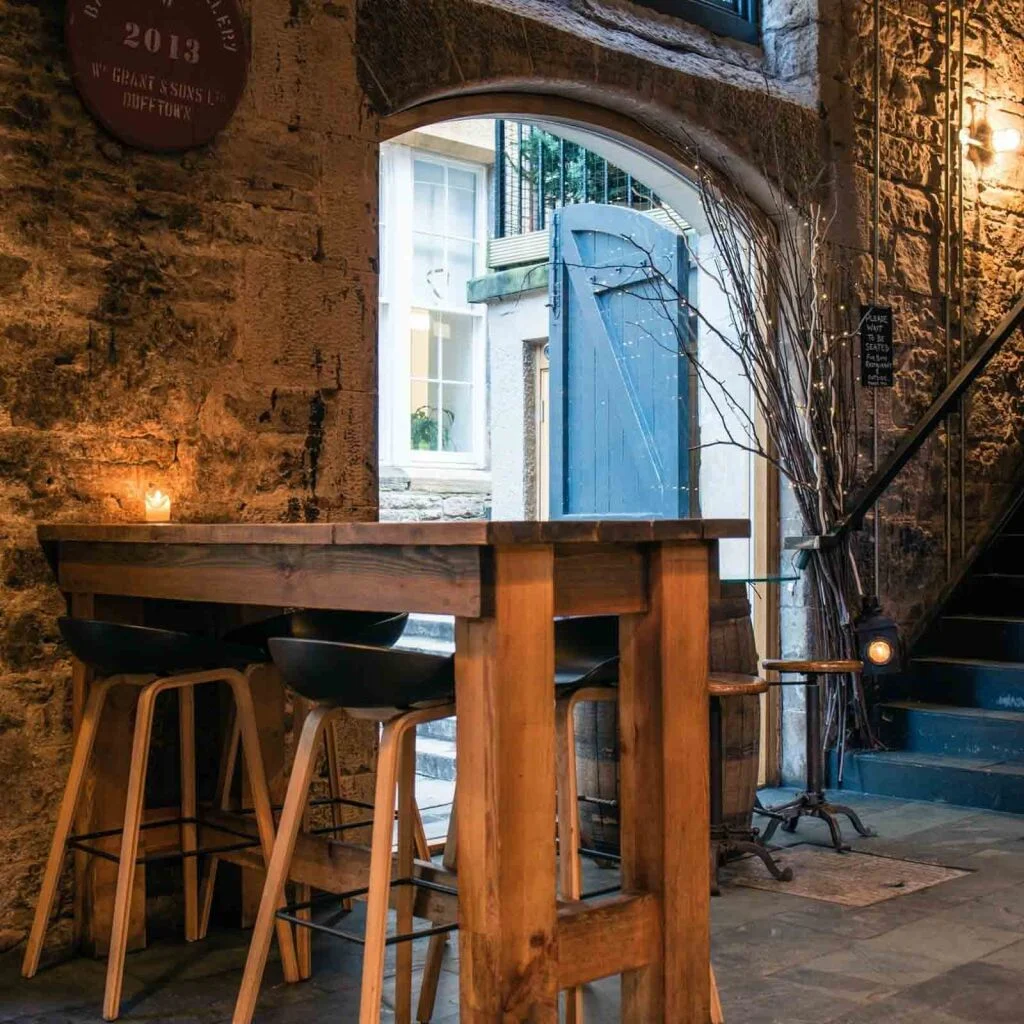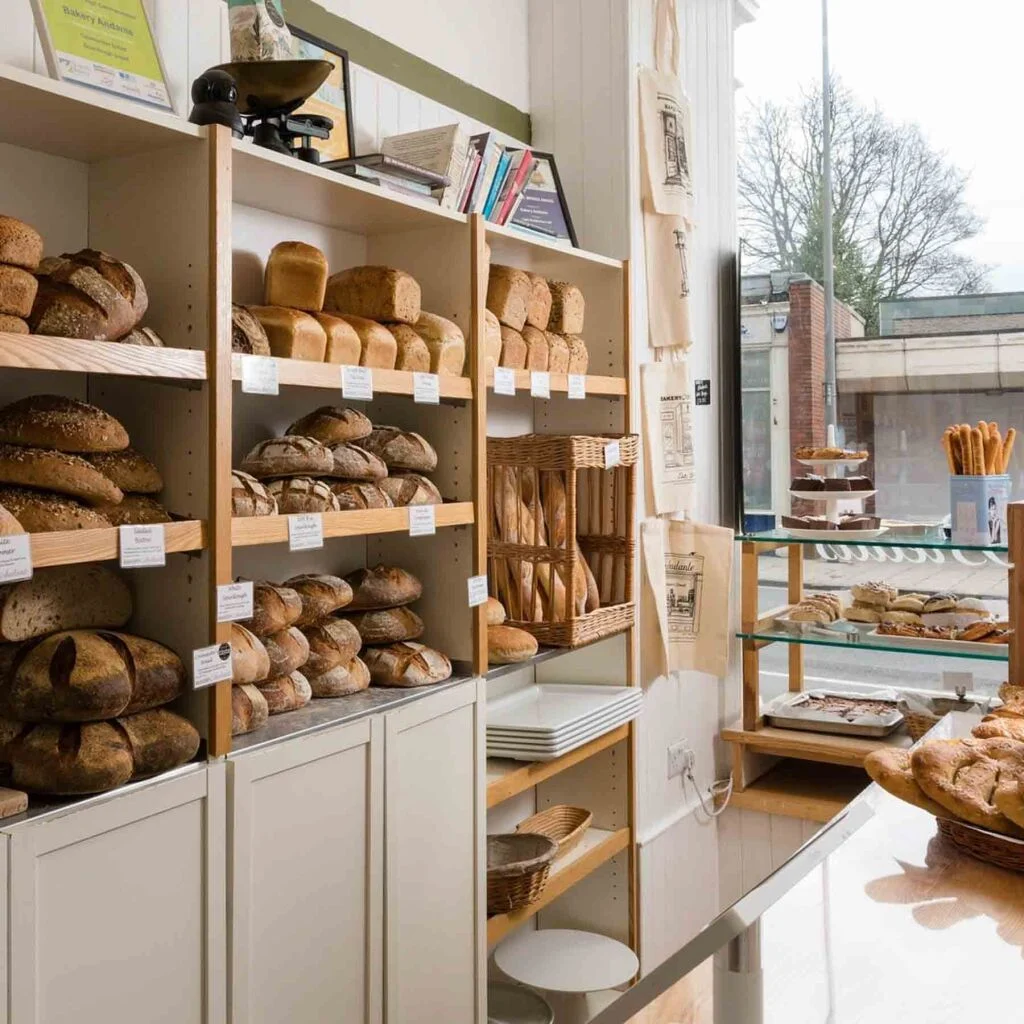Writing about traditional meals served across London is a little complex.
Like many large cities, London is an incredible melting pot of flavors and influences, spoiling visitors for choice.
I’ll never forget my first visit to London. I remember meandering through the alleyways of Camden, seeking out a roast dinner on a Sunday. Little did I know, my belly would be idle for the rest of the day because of the sheer amount of food in one serving.
Here, I’m going to fill you in on some of London’s most historically traditional dishes and the best foods you need to try when you get here. Let’s get started.
A Hearty Start with the Traditional English Breakfast
For some, myself included, this is the only way to start their day in London. A full English, commonly known as a fry-up, is the heartiest, highest-carb breakfast you’ll find anywhere in the UK.
Let me tell you, it is truly delicious, but it’s not for the faint of heart. The plate is filled to the brim with any kind of greasy food you can think of. From streaky, smoky bacon straight from the pan to baked beans covered in thick molasses and salt pork sauce.
While a full English breakfast is mainly eaten in the morning, it can also be served as brunch, which you’ll find in many establishments.
This iconic plate has been passed down through generations. It originated from the affluent classes in the 1300s. Indulging in one of these monstrous portions was a massive sign of wealth since food was only readily available to the upper class.
It typically includes the following:
- Crispy-edged fried eggs
- Fluffy scrambled eggs
- Crunchy bacon
- Sizzling sausages
- Baked beans
- Fried bread (yes, bread fried in oil)
- Buttered fried potatoes
- Crunchy chips
- Rich black pudding
- Oily mushrooms
- Fresh tomatoes
Naturally, this is accompanied by a cup of tea, coffee, or juice. However, there are many variations on the theme, and you can add or exclude any items you would like.
Vegetarians, too, are well served – for whom an English breakfast will often include vegetarian sausages.
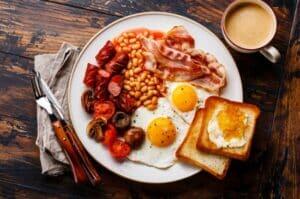
Where to Eat an English Breakfast
You’ll find an English breakfast on the menu at most hotels and cafes in London. You can even pick one up at a gas station early in the morning.
One of my favorite places for an English breakfast in London is the Regency Cafe.
From the outside, this place might not look like anything special; in fact, it seems like an abandoned building. But trust me, these guys know what they’re doing when it comes to a fry-up.
Their set breakfast deal includes a range of tasty bites. They provide a fried egg with an oozing yolk, two pieces of streaky bacon, a choice of slow-simmered beans or tomatoes, crispy toast or fresh bread, and a warm cup of tea or aromatic coffee.
I visited this place twice on my last trip to London. The second time around, I decided to go for the omelet. All of the local builders who were huddled around the table beside me told me I couldn’t leave without trying it. And it did not disappoint, from the crispy onions to the mildly sweet bell peppers; when you mix it in with French fries, the flavor is like heaven.
The line here usually forms from 9 a.m., so if you can get yourself down there beforehand, you’ll be in for some luck. Fortunately, the food comes out so fast.
Pie And Mash
East London boy David Beckham visited his favorite pie and mash shop at the height of his football career. This returned the famed dish to the top of the menu for many.
Pie and mash is an East End favorite that has been putting smiles on the faces of Britons for some time now. The pie part is formed with a light, flaky puff pastry that breaks when it hits your mouth.
On the inside are tender pieces of sliced beef drenched in gravy. To complement it is a side of creamy mashed potatoes. This has to be served smoking hot, so much so that the pastry is almost starting to break before you’ve started to eat it.
Additionally, a liquor sauce should be served on the side to go with the dish made from parsley, butter, and milk. This water is used to cook the fresh eels, usually served alongside pie and mash.
Back in the 1700s, the people of London ate eels because of their affordability and the sheer number of them found in the River Thames.
Pie and mash shops across the city came up with the bright idea to offer them as a side to complement the famous combo, and it has stuck ever since.
How this side is made may turn your stomach as it did mine, but they really don’t taste all that bad.
The eels are left to cool in water after they have been caught before being boiled in vinegar, peppercorns, bay leaves, salt, and sliced onions.
Once the preparation is carried out correctly, a jelly should form around the outside of the eel, making it even slipperier than before it was caught.

Where to Eat Pie & Mash
If you’re going to try pie & mash, you might as well do it at one of the oldest restaurants serving the specialty in London, M.Manze Pie & Mash.
I have tried countless pies, and nothing comes close to the ones M.Manze Pie & Mash.
Their handmade pastry goes so well with the prime cuts of beef covered in the rich gravy. They also cook and jelly their eels on-site to make sure they turn out really juicy, just as the local traders like them.
My vegan readers don’t have to worry. M.Manze Pie & Mash also offers a crisp vegan pie with dairy-free mashed potatoes and a bowl of liquor sauce. But let me warn you in advance: the broth is strong because of the overwhelming peppery taste of parsley, so prepare yourself!
Eat your pie as the locals do it by ordering an extra burnt pie. The owner, George, will have no problem charring it a little for you so the fillings reach the right texture, making a tastier pie.
Fish and Chips
A trip to a good old chippy for one of my favorite dishes, a battered fish and chips, is a must after a couple of pints of Fosters while you’re in London.
Fish and chips is a serious British comfort food. The fish served is usually white fish, either a flaky cod or a mild haddock fried in a crispy batter. Along with golden brown chips and a side order of mushy or pureed pale green peas, crunchy onion rings, and tartar sauce.
Jewish refugees from Portugal and Spain brought this combination to Britain in the 17th century. The first fish and chip shop opened in London in 1860.
Chippies have long been a huge part of British society; during the 1920s, it was estimated that there were 35,000 in the country. Since then, that number has significantly dropped to around 10,500, but that’s still a staggering figure.
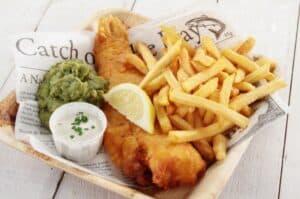
Where to Eat Fish and Chips
I could spend days naming you some of London’s best fish and chips shops. But there’s one place that stands out among the others, and that’s the Golden Hind.
The way these guys do fish and chips is unbeatable, from the crispiness of the batter to the thickness of the hand-cut chips.
The Golden Hind has been in business for over 100 years now. The premises are tucked away on Marylebone Lane, and hundreds of fish and chips lovers walk through its doors daily.
When you’re faced with choosing which fish to enjoy, you have so many options, from the class large boneless cod to the delectable breaded scampi. Don’t forget to order yourself a portion of chips with them, and get some creamy and tangy tartare sauce for dipping.
Every time I walk past the Golden Hind, it’s packed with people. But the staff keeps everything under control and ensures everyone enjoys their fish and chips in peace.
There are some additional fish options on the menu; it’s not just white fish.
I loved the oiliness of the homemade salmon fish cakes, although that much oil isn’t for everyone. Also, the lemon zest dominated my palette, but it was such a nice touch.
If the weather is nice on the day you visit the Golden Hind, sit outside. The inside can get quite crammed because of how popular it is, whereas you’ll have plenty of breathing space out front.
Sunday Roast
Are you ready for a feast? The first time I had a Sunday Roast in London, I couldn’t believe what was in front of my eyes. When locals say it’s a grand meal, they really aren’t lying.
A roast dinner is most commonly served at Sunday lunchtime. You pick your choice of meat, either succulent roast beef, roasted chicken, herb-infused pork, or seasoned lamb.
It will be served with:
- Glistening roasted potatoes
- A baked Yorkshire Pudding (a batter-style bread pudding)
- Garden-fresh roasted vegetables
- Rich gravy
Personally, my favorite part about a Sunday Roast is the gravy. I love the rich thickness of the sauce made from the pan drippings and the taste when you pour it over the roasted meat; it’s sensational.
The Sunday Dinner concept dates back to the 15th century. It comes from the hearty meal of meat and potatoes that landowners would reward their laborers with each week after church.
Meanwhile, roast beef has long been part of Britain’s culinary tradition. In the 18th century, Henry Fielding praised it as an, “Englishman’s food which ennobled our brains and enriched our blood.”
A Sunday Roast is a time for families and friends to come together and bond over a massive banquet.
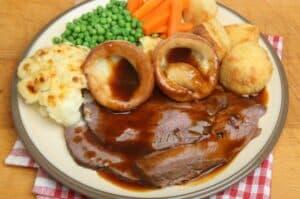
Where to Eat a Sunday Roast
Once Sunday comes around, pubs all across London will usually introduce their “Sunday Menu.” It tends to be different from their standard menu, and at the top of it will be a big tasty roast.
One of the best places to experience this is at the Jugged Hare on the city’s fringes on Chiswell Street. Not only are all of their dishes crafted with locally sourced ingredients with sustainability in mind, but the service is outstanding. Plus, the portions are huge.
The 45-day aged Longhorn beef with horseradish sauce is one of their big sellers. The sharp, pungent smell is the first thing that hits you when you walk through the venue’s doors on a Sunday afternoon. When you add it to the duck roast fat potatoes, it has a slightly sweet taste to it.
If you have some space left over, I urge you to try the baked vanilla cheesecake. I found it quite heavy and very luscious, but when I added the fresh blueberries and mixed in a spoonful of the delectable chocolate sorbet, the sweetness was totally worth feeling like a pig for.
My advice would be to book ahead and to get down there as early as possible. I have never seen this place not busy. Sometimes, one certain meat can sell out, and you could end up waiting for an extra half hour to an hour for the chef to cook the next batch.
Bangers and Mash
No trip to London is complete without a scrumptious portion of fried bangers and creamy mash. Much like the previously mentioned pie and mash, this dish is very similar. Only a greasy serving of sausages topped with onion gravy replaces the pie.
Bangers and mash have been an integral part of London’s culinary heritage since the early 20th century. The idea of the dish dates back to World War 1. Shortages of meats were pretty standard, leading to sausages being made with meat fillers like water, causing them to explode because of the pressure from the steam.
That’s where the term “bangers” came from.
You’ll find that bangers and mash are served in different variations all over London.
Some restaurants will allow you to choose the different types of sausages to add (Cumberland, pork, chicken, Lincolnshire, vegetarian, etc.). Whereas others may give you the option to pick your mash styles, like herby buttermilk or sweet potato mash.
It’s amazing how something so basic tastes so appetizing!
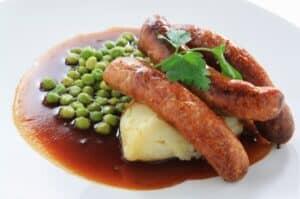
Where to Eat Bangers and Mash
All of the best restaurants in London serve bangers and mash, but none quite like Mother Mash.
They have two fantastic venues across the capital, one in Soho and another in Covent Garden. All are decked out with fashionable dining spaces featuring white subway tiles and authentic marbled tables, perfect for dining.
The menu at Mother Mash is simple yet oh-so-delicious. It gives visitors the option to choose their style of mash, from cheesy mustard with mature cheddar to natural mash with creamy horseradish.
For the main course, visitors can select butcher-quality bangers or locally sourced pies. You can also pick the type of gravy with options like a caramelized onion with a vegetarian stock version or smoked bacon.
Torn on what to order? It’s hard to comprehend how a menu so small can spoil you for choice, but that’s what Mother Mash does. The staff here are very helpful with recommendations; they’re well used to tourists coming in, so they’ll be able to give you some suggestions.
Beef Wellington
You better save this one for your main course because it’s quite heavy. Beef Wellington holds a special place in my heart. For me, it’s the rich, creamy pâté combined with the tender beef; it has a mild sweetness to it but is not too overpowering, and the herbs explode with flavor all through the mouth.
This dish is made with a delicate beef fillet covered in pâté, duxelles formed from chopped mushrooms, and parma ham and puff pastry.
The name Beef Wellington is believed to have stemmed from the first Duke of Wellington (Arthur Wellesley). He ruled victory over Napolean Bonaparte during the Battle of Waterloo in 1815. Of course, a dish this tasty deserved a legendary title!

Where to Eat Beef Wellington
You might expect Beef Wellington to be served in high-end establishments only. But you can also find it offered in a couple of quintessential British pubs like the Grenadier (£££) in Belgravia Square near Kensington, a common go-to of mine.
This establishment is famed for its take on Beef Wellington with truffled mushrooms, potato fondant, greens, and carrots. I have tried a lot of this dish in my time, but nothing quite like this. The pastry was so flaky it dissolved on my tongue, and the creaminess from the fondant was remarkable.
I fell in love with the atmosphere at the Grenadier; it’s set inside an inconspicuous building. It boasts typical Victorian aesthetics and furnishings, the ideal setting for your first Beef Wellington.
I would describe the Grenadier as a high-end bar since it still has a typical pub vibe to it. Visitors are also welcome to enjoy their food at the bar if they wish.
If your foodie buddies aren’t too fussed about the Beef Wellington, the Grenadier also has plenty of other delightful options. Some include the Scotch Egg paired with a zesty Mustard Mayo Dip, or the Glazed English Duck Breast drizzled with Honey.
Not to scare you off, but the Grenadier is rumored to be haunted, so don’t be frightened if you catch some paranormal activity.
Finding the Grandier can be tricky since it’s wedged down the end of a quaint little alleyway, so use Google Maps to help you find it. You don’t want to be late for your reservation!
Bubble and Squeak
Bubble and Squeak is undoubtedly one of London’s most popular appetizer dishes, and now one of my favorites. I’m a huge fan of fried food. Seeing the way they fried up a bunch of leftover vegetables and potatos, drenched in oil, filled my tummy and me with excitement.
The recipe differs depending on the chef cooking it. Some of the most common ingredients include fresh cabbage, light breadcrumbs, green peas, kale, carrots, and onions. It’s quite similar to the recipe they make in Scotland, called Rumbledethumps, which I was also a massive fan of for the peppered cabbage.
The concept of Bubble and Squeak came from tough times in Britain during World War 2 when food was scarce (like a lot of traditional dishes). People used whatever they could find and fried it up to fill up for the day.
You’re probably wondering why the name Bubble and Squeak? Well, it’s traditionally linked to the sound made when all the ingredients first hit the frying pan. It makes a lot of spluttering and crackling, so that’s where it comes from.
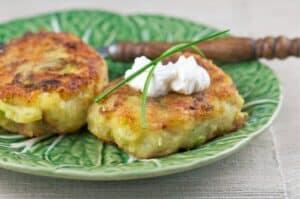
Where to eat Bubble and Squeak
There’s no better place to try Bubble and Squeak than Maria’s Market Cafe in the heart of the Borough Market. It’s a street food style market offering the finest London foods around.
Maria’s Market Cafe is your typical breakfast joint that has been serving the great people of London since 1961. Their Bubble and Squeak recipe was truly divine when I had it. Maybe it was the herby-flavored vegetables they use or the way they fried it until it reached the perfect level of crunchiness.
I got the vibe it was a no-frills kind of spot with only a couple of sets of tables and chairs and many people coming and going to get their takeaway servings. And let me tell you, this place got busy during my visit, so be there early.
The Bubble and Squeak at Maria’s Market Cafe (££) was served as a side with one of the breakfast dishes, I went for the fry-up. I still craved some more Bubble and Squeak after, so I ordered more as a side.
Bear in mind that Bubble and Squeak is only served here in the mornings between 7 a.m. and 12 p.m.
The menu also features veggie and vegan-style breakfast, smoked salmon, and scrambled eggs. Along with a few other selections if you’re open to something different.
Plus, their coffee is amazing, especially the Machiattos. The expresso-to-milk ratio was perfect; it was exactly like you’d find it in Italy, only a drop of cream and one single shot.
Victoria Sponge Cake
Next, we have something for those with a sweet tooth, me included. Victoria Sponge Cake is a staple dessert of British society, and now my diet, that originates from traditional afternoon tea sessions back in the Victorian era.
Victoria Sponge Cake is pretty light compared to other cakes. It has a double-rounded base with a light spread of clotted cream, fresh jam, and sometimes even custard. The top of the sponge is often speckled with sugar for some added sweetness as if there wasn’t enough already.
My favorite way to have Victoria Sponge Cake is Classic Sandwich Style, where one layer is covered in fresh jam and another with cream. They’re squeezed together, and cream leaks out of the side; it’s a big, yummy mess, just how I like it.
Evidence suggests that Victoria Sponge Cake can be linked back to the 15th century. Anne Russell, the Seventh Duchess of Bedford, and Queen Victoria were rumored to be huge fans of the luscious dessert.
They ordered it to be served to them for their afternoons while they waited for High Tea (evening meal). That’s where the concept of Afternoon Tea came from.
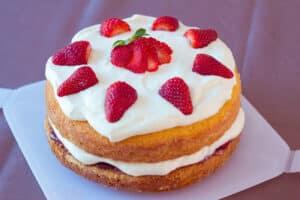
Where to Eat Victoria Sponge Cake
Book in for some Afternoon Tea at Fortnum & Mason’s Diamond Jubilee Tea Salon in Picadilly.
Fortnum & Mason takes elegance to a whole other level with refined interiors and ornate detailing. You’ll feel like true royalty here!
The Afternoon Tea package at Fortnum & Mason includes a mouthwatering serving of pumpkin sponge cake. As well as a nice selection of freshly cut cold sandwiches and plain and fruity scones.
I will say it’s pretty expensive to have afternoon tea here. But the effort put into the service, the standard of food and high-quality teas, and the luxurious setting all justify the price.
Anyone who wants to skip the afternoon tea and go straight for the Victoria Sponge Cake should check out Big Jo’s (£) at Falconer Walk. It’s a little bit outside the center but deserving of a visit from sugar cravers.
Indian Food
If you have visited London before, you’ll already know that Indian food is hugely popular. Between Britain colonizing India for almost 200 years and the mass immigration of Indian nationals to the country during this time. There are plenty of reasons for this.
Whether you fancy a spicy Madras curry or a chicken tikka masala, you can find almost any Indian food you can think of in London.
You might think because Indian food isn’t part of British cuisine that, it won’t be as good as it is in India. But trust us, the standard is incredible since the Indian diaspora in London is well and truly alive.
On every second corner, you’ll find traditional spice shops, little chai stalls, and grocery stores offering imported goods.
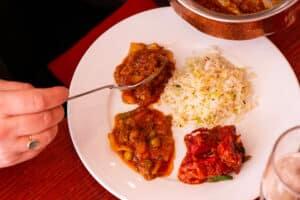
Where to Eat Indian Food
It’s true you can find Indian food wherever you go in London. But Brick Lane is seen as the focal point of the Indian culinary scene in the British capital due to a huge inflow of migrants who arrived in the 1970s.
Aladin is the holy grail of chicken tikka masala and other curries in Brick Lane. Opened in 1979, over the years they have racked up countless awards for their dishes and overtaken the rest of the restaurants in the area, 4 floors, and a function room to cater for larger parties.
Some of Aladin’s menu’s highlights includes:
- Lamb Blast
- Fiery madras curry
- Tandoori King Prawn Bast
- Aroma-filled biryani
- The great, well-balanced chicken tikka masala.
You’ll be spoiled for choice!
Boiled Eggs and Soldiers
Boiled eggs and soldiers is a less heavy alternative to a traditional English breakfast fry-up.
The dish comes with soft-boiled eggs with runny yolks and a few pieces of toast with butter cut into smaller rectangle-shaped pieces called “soldiers.” These are used for dipping.
Plenty of eateries around London will allow you to substitute boiled eggs with fried eggs if you wish. After all, boiled aren’t for everyone.
I know all about boiled eggs and soldiers. I grew up eating this dish. When I got to London for the first time and had it, a huge feeling of nostalgia came over me. It’s a common breakfast recipe amongst British mothers since it’s so easy to make. The eggs should be served in egg cups with a small teaspoon to crack the top off.

Where to Eat Boiled Eggs and Soldiers
The number 1 restaurant to try boiled eggs and soldiers in London is the Wolseley (££) in Mayfair.
It was established in 2003 after the owners, Chris Corbin and Jeremy King, took over the early 1920s building. Today, it’s one of the main ports of call for many Londoners looking to savor a morning feast stylishly.
Not only has the Wolsely built up a huge reputation for its amazing food, but the marvelous aesthetics are a feast for the eyes. From sparkling pendant lights to the pristine table settings.
For a fair price, you can get a nicely sized portion of 2 freshly boiled eggs with toasted soldiers and a size of butter at the Wolseley. They cook the eggs perfectly; the yolk isn’t too hard or too soft; it’s just the right texture for dipping.
The breakfast menu at the Wolseley does have many more options other than boiled eggs and soldiers, too.
Their traditional English breakfast would give anywhere else in London a run for its money. Especially for their fried eggs, which were peppered to perfection. And the nourishing smoothie options like apple or mixed berries.
Also, a selection of pastries, including irresistible Pain au Chocolats (which I treated myself to before I left), cereals and fruits, and teas and coffees are all available too.
Conclusion
I hope you enjoyed my list of where to eat London’s traditional foods. Trust me, the city is a culinary gem with endless dishes that are sure to tease your taste buds. If you’d prefer to let a local take you around and try some of the dishes on this list while learning a bit about the history and culture, check out our food tours.
Before you touch down, read our list of the best afternoon tea in London so you can hit the ground running.

